6) Functional Polymer Materials, Functional Molecular Assemblies
6-1) Novel Ion Conductive Materials Based on Ionic Bicontinuous Cubic Liquid Crystals
Wedge-shaped ammonium and phosphonium salts self-assemble into bicontinuous cubic liquid-crystalline structures having three-dimensionally interconnected ionic nanochannels. Synchrotron small-angle X-ray measurements have been performed to construct the electron density maps in the bicontinuous cubic phases. The location of anions in the bicontinuous cubic structures has been revealed by novel differential mapping technique.
(collaboration with Prof. H. Ohno in Tokyo University of Agriculture and Technology and Prof. G. Ungar in University of Sheffield)

Selected papers on this subject:
-
Induction of Thermotropic Bicontinuous Cubic Phases in Liquid-Crystalline Ammonium and Phosphonium Salts
Takahiro Ichikawa, Masafumi Yoshio, Atsushi Hamasaki, Satomi Taguchi, Feng Liu, Xiang-bing Zeng, Goran Ungar, Hiroyuki Ohno, and Takashi Kato
J. Am. Chem. Soc., 134, 2634 (2012)
-
Self-Organization of Room-Temperature Ionic Liquids Exhibiting Liquid-Crystalline Bicontinuous Cubic Phases: Formation of Nano-Ion Channel Networks
Takahiro Ichikawa, Masafumi Yoshio, Atsushi Hamasaki, Tomohiro Mukai, Hiroyuki Ohno, and Takashi Kato
J. Am. Chem. Soc., 129, 10662 (2007)
6-2) Development of Anisotropically Ion-Conductive Nanostructured Films
We have developed anisotropically ion-conductive film materials through fixation of highly organized nanostructures of liquid crystals.
Nano-segregated anisotropic films are constructed by the photopolymerization of liquid-crystalline monomers that consist of incompatible ionophilic moiety (polyethyleneoxide) and lipophilic mesogenic moiety. These materials can transport ions in specific directions, and very high level of ionic conductivities around 10-3 S cm-1 are obtained at ambient temprature.
(collaboration with Prof. H. Ohno, Dept. of Biotechnology, Tokyo Univ. of Agriculture and Technology)
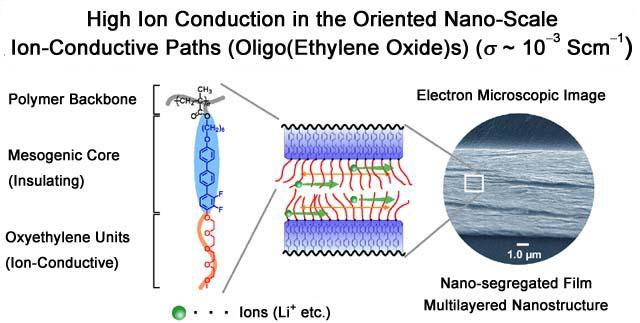
Selected papers on this subject:
-
Nano-Segregated Polymeric Film Exhibiting High Ionic Conductivities
Kenji Kishimoto, Tomoyuki Suzawa, Tomoki Yokota, Tomohiro Mukai, Hiroyuki Ohno, and Takashi Kato
J. Am. Chem. Soc., 127, 15618 (2005).
-
Nanostructured Anisotropic Ion-Conductive Films
K. Kishimoto, M. Yoshio, T. Mukai, M. Yoshizawa, H. Ohno, and T. Kato
J. Am. Chem. Soc., 125, 3196 (2003).
6-3) Development of Columnar Liquid-Crystalline π-Conjugated Molecules
We have succeeded in the preparation of liquid-crystalline oligothiophenes that self-assemble into one-dimensional columnar stacks.

Selected papers on this subject:
-
Columnar Liquid Crystalline π-Conjugated Oligothiophenes
Takuma Yasuda, Kenji Kishimoto, and Takashi Kato
Chem. Commun., 2006, 3399.
-
Oligothiophene-Based Liquid Crystals Exhibiting Smectic A Phases in Wider Temperature Ranges
Masaomi Kimura, Takuma Yasuda, Kenji Kishimoto, Günther Götz, Peter Bäuerle, and Takashi Kato
Chem. Lett., 35, 1150 (2006).
6-4) Stimuli-Responsive Luminescent Liquid Crystals: Change of Photoluminescent Colors Triggered by a Shear-Induced Phase Transition
A stimuli-responsive liquid crystal showing the change of the photoluminescent color on the shear-induced liquid-crystalline phase transition has been developed. A pyrene derivative having amide groups and dendritic side chains shows a micellar cubic phase. In this cubic phase, the compound exhibits yellow photoluminescence arising from the excimer formation of luminescent cores. By mechanical shearing for the compound in the cubic phase, a shear-induced cubic-columnar liquid-crystalline phase transition occurs, leading to the change of the photoluminescent color from yellow to blue-green. Such stimuli-responsive liquid crystals are promising candidates for sensing devices or memories.

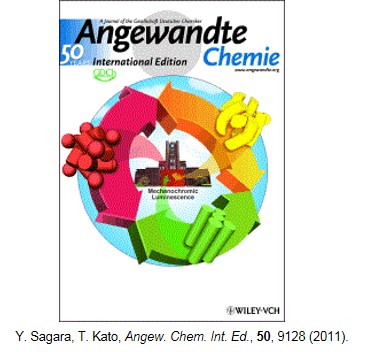
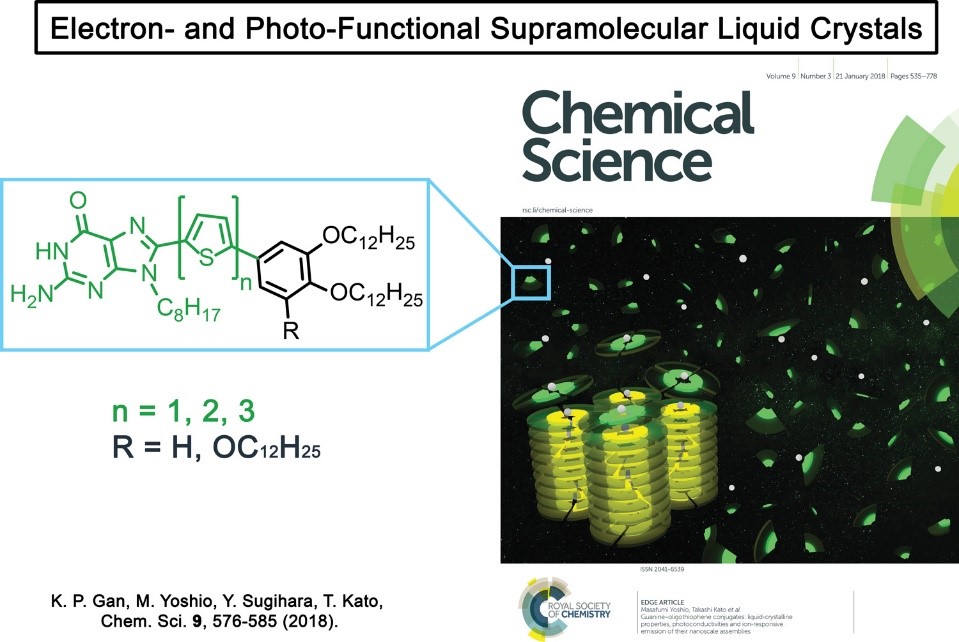
Selected papers on this subject:
-
Guanine-Oligothiophene Conjugates: Liquid-Crystalline Properties, Photoconductivities and Ion-Responsive Emission of Their Nanoscale Assemblies
Kian Ping Gan, Masafumi Yoshio, Yuki Sugihara and Takashi Kato
Chem. Sci., 9, 576-585 (2018)
-
Tuning of Luminescence Color of p-conjugated Liquid Crystals through Co-Assembly with Ionic Liquids
Masato Mitani, Masafumi Yoshio and Takashi Kato
J. Mater. Chem. C, 5, 9972-9978 (2017).
-
Brightly Tricolored Mechanochromic Luminescence from a Single-Luminophore Liquid Crystal: Reversible Writing and Erasing of Images
Yoshimitsu Sagara and Takashi Kato
Angew. Chem. Int. Ed., 50, 9128 (2011).
-
Mechanically Induced Luminescence Changes in Molecular Assemblies
Yoshimitsu Sagara and Takashi Kato
Nature Chemistry, 1, 605 (2009).
-
Stimuli-Responsive Luminescent Liquid Crystals: Change of Photoluminescent Colors Triggered by a Shear-Induced Phase Transition
Yoshimitsu Sagara and Takashi Kato
Angew. Chem. Int. Ed., 47, 5175 (2008).
6-5) Development of Full-Color Tunable Photoluminescent Ionic Liquid Crystals
We have prepared tripodal ionic liquid crystals by introducing electron-donating parts into electron-accepting cationic parts. These ionic liquid crystals exhibit photoluminescence, and the emission colors cover visible region simply by changing electron-donating and/or accepting characters.
(collaboration with Prof. M. Hasegawa, Dept. of Chemistry and Biological Science, Aoyama Gakuin Univ.)
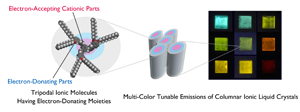
Selected papers on this subject:
-
Full-Color Tunable Photoluminescent Ionic Liquid Crystals Based on Tripodal Pyridinium, Pyrimidinium, and Quinolinium Salts
Kana Tanabe, Yuko Suzui, Miki Hasegawa, and Takashi Kato
J. Am. Chem. Soc., 134, 5652-5661 (2012).
-
Luminescent Ionic Liquid Crystals Based on Tripodal Pyridinium Salts
Kana Tanabe, Takuma Yasuda, and Takashi Kato
Chem. Lett., 37, 1208 (2008).
6-6) Construction of Aligned Opto- and Electroactive Self-Assembled Fibers
Aligned electroactive fibers have been formed by anisotropic self-assembly of hydrogen-bonded amino acid derivatives having tetrathiafulvalene (TTF) moieties in liquid crystals. After iodine doping, the self-assembled fibers exhibit electronic conductivity.
(collaboration with Prof. K. Ito, Graduate School of Frontier Sciences, The Univ. Tokyo)
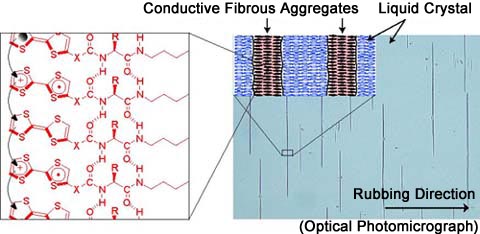
A series of amino acid derivatives having photoconductive carbazole moieties are synthesized. Aligned fibers are formed via anisotropic self-assembly of the hydrogen-bonded molecules in liquid crystals. These aligned fibers are expected to show anisotropic opto- and electronic functions.
Selected papers on this subject:
-
Electroactive Supramolecular Self-Assembled Fibers Comprised of Doped Tetrathiafulvalene-Based Gelators
Tetsu Kitamura, Suguru Nakaso, Norihiro Mizoshita, Yusuke Tochigi, Takeshi Shimomura, Masaya Moriyama, Kohzo Ito, and Takashi Kato
J. Am. Chem. Soc., 127, 14769 (2005).
-
Self-Assembly of Carbazole-Containing Gelators: Alignment of the Chromophore in Fibrous Aggregates
Kazuhiro Yabuuchi, Yusuke Tochigi, Norihiro Mizoshita, Kenji Hanabusa, and Takashi Kato
Tetrahedron, 63, 7358 (2007).
-
Liquid-Crystalline Physical Gels
Takashi Kato, Yuki Hirai, Suguru Nakaso, and Masaya Moriyama
Chem. Soc. Rev., 36, 1857 (2007).
6-7) Development of Redox-Active Liquid Crystals
We have prepared redox-active liquid crystals derived from viologens that form columnar phases. These viologens exhibit electrochromism with the color change from light-yellow to dark-blue during electrochemical reduction.
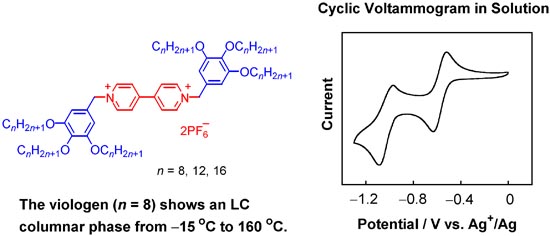
Selected papers on this subject:
-
Viologen-Based Redox-Active Ionic Liquid Crystals Forming Columnar Phases
Kana Tanabe, Takuma Yasuda, Masafumi Yoshio, and Takashi Kato
Org. Lett., 9, 4271 (2007).
[Back]








